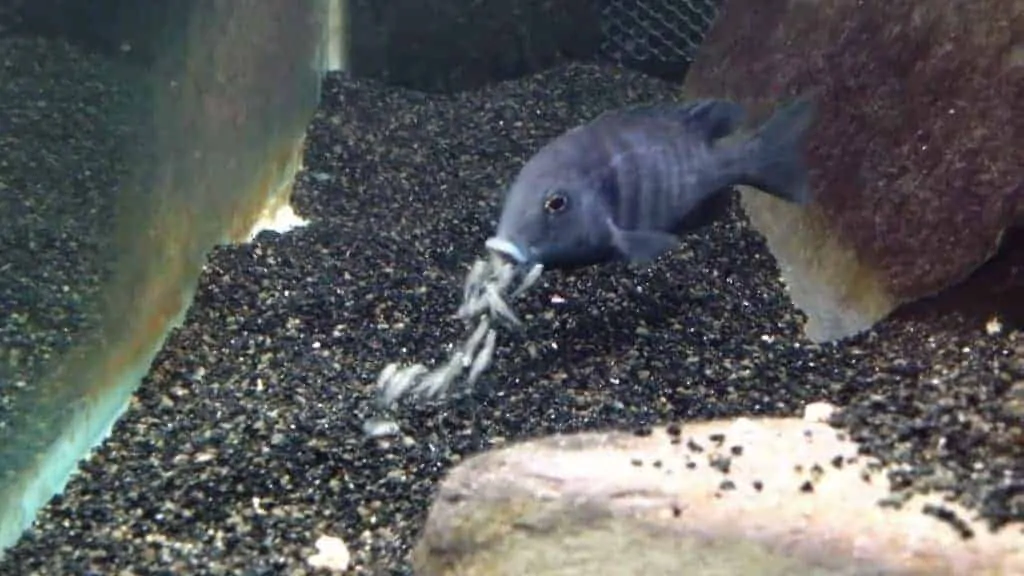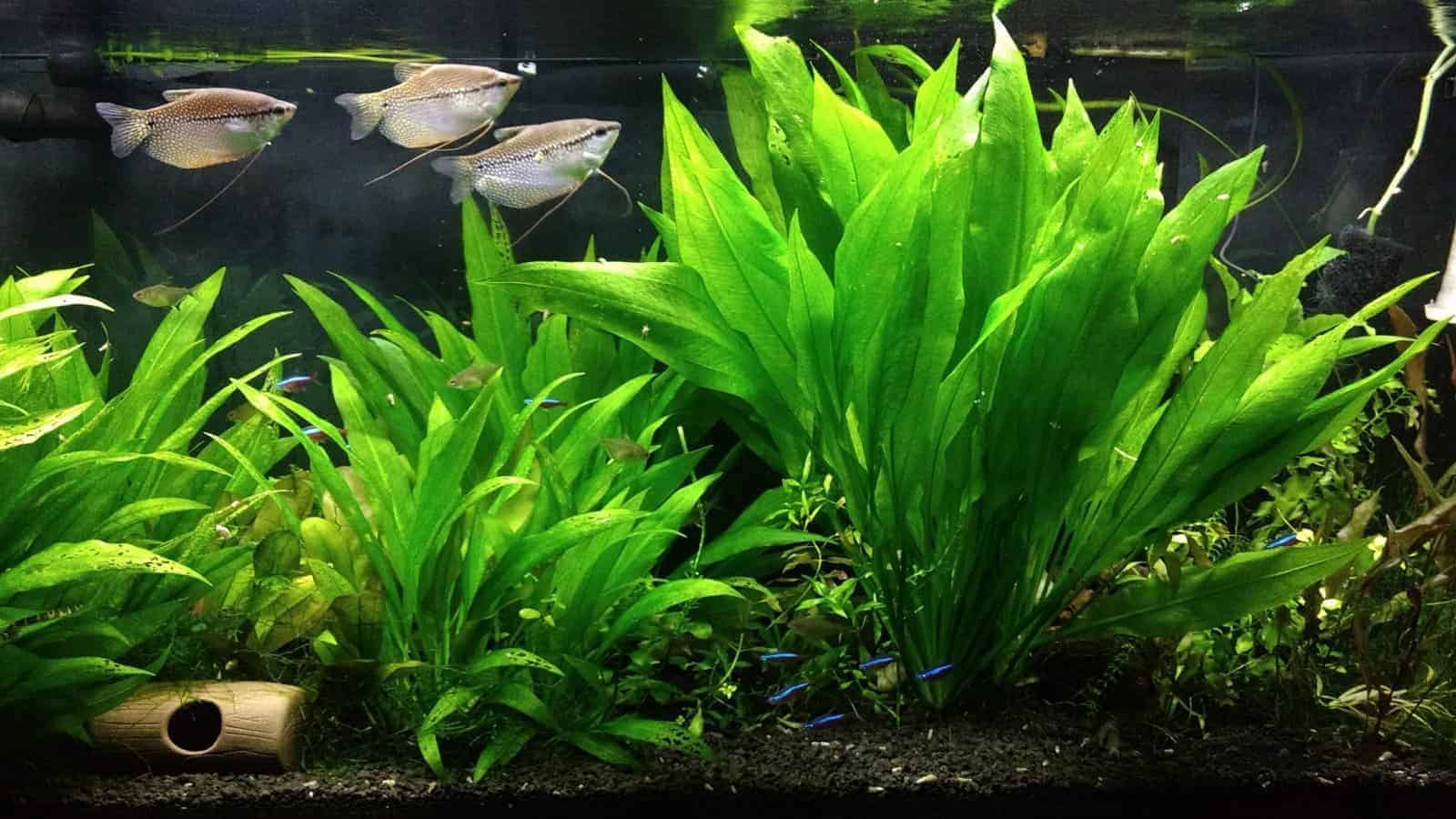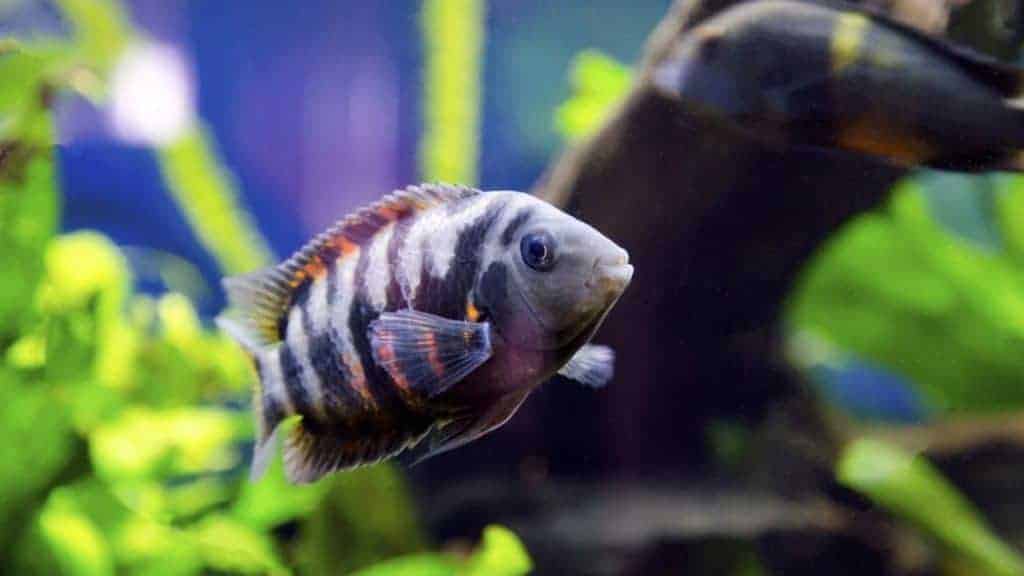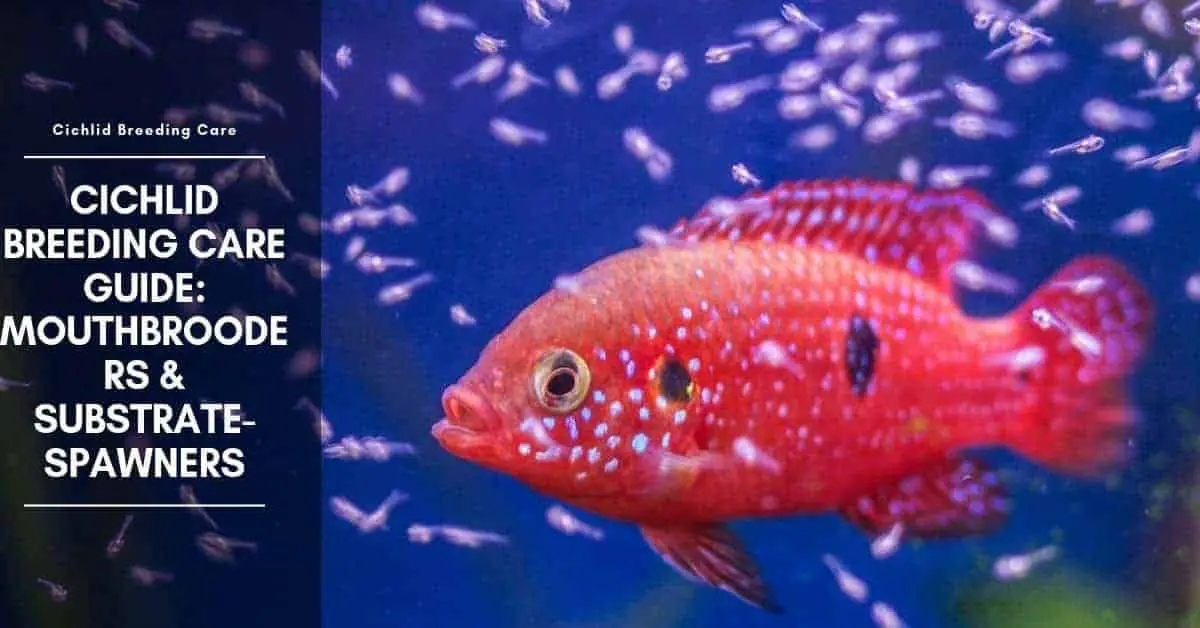Cichlids are a fascinating group of fish to breed because, as far as we know, all species practice brood care of some sort. They are usually divided into two main groups: mouthbrooders and substrate-spawners. However, things are nowhere near as clear-cut as this, since these two main categories can be subdivided depending on who cares for the young, what substrate is used to lay their eggs on, and who guards the territory.
Mouthbrooding Cichlids

Mouthbrooders pick up their fertilized eggs and hold them in the mouth until the young are large enough to venture out into the world. Some species will take their babies back into the mouth in times of danger, while others ignore them once they have been released.
The big advantage these fish have over most other fish is that their eggs are relatively safe in the adult’s mouth and most will at least reach the free-swimming stage. The downside is that fewer eggs are produced in each spawning and most adults stop feeding while brooding their eggs. This means they need longer to recover between spawnings than many of their substrate-spawning cousins.
The most commonly seen mouth-brooders are mbuna from Lake Malawi. In these species, the female cares for the eggs and males will spawn with any passing ripe female. Mixed communities of these fish often produce hybrids, so if you want to breed mbuna (African cichlids), keep them in a species only aquarium with one male to three or four females.
Substrate-spawning Cichlids
We tend to think of substrate-spawners as fish that lay their eggs on a rock or in a pit in the gravel. However, in the case of cichlids, the substrate means any surface to which the fish attaches its eggs – a leaf, the roof of a cave, a vertical piece of slate, or even the aquarium glass.
Once laid, one or both parents will care for the eggs, regularly fanning them to keep well-oxygenated water passing over them, removing any eggs that show signs of fungus, and chasing away any fish that approaches. Some species have to help their fry out of the egg case when they hatch: otherwise the young will die trapped inside.
In most cichlids, the female undertakes the bulk of caring for the youngsters, while the male takes a more active role in defending the territory. In some species, this has reached the point where a male will guard a territory that includes several brooding females, a strategy known as harem polygyny.
Once the eggs have hatched, most substrate- spawners move their offspring into a pit dug in the gravel. When they are free-swimming, the youngsters are herded about toward the best feeding sites. Care usually continues until the adults are ready to breed again, at which time they will often return to the same spawning site they used before. A few species will breed with their older brood still in tow and the older babies may even take an active part in caring for their younger siblings.
Some substrate-spawners spawn right out in the open on a rock or in a pit. They are described as open-brooders and tend to be large fish with less to fear from predators. Cave-brooders are often smaller, timider fish that appreciate plenty of places to hide.
Typical Spawning Setup
Since most community fish will attempt to eat the eggs or young of any fish that breed in the tank, it is always best to set up a separate breeding tank. This applies particularly to cichlids, since they often dig up plants, attack other fish, and generally cause mayhem in a community aquarium when breeding.
The spawning setup should be large enough to comfortably accommodate both parents or a breeding group of adults. For large species, you might need an aquarium 1.8 m (6 ft) long. Since it will be a permanent home for the adults, it should include filtration (an external power filter is probably best) and suitable decor. For most species, this means plenty of rockwork, caves, and other hideaways.
Dwarf cichlids will appreciate some plant cover, while angelfish and discus use large Amazon sword plants as spawning sites.
API STRESS COAT Aquarium Water Conditioner 16-Ounce Bottle
Tetra AquaSafe Plus, 8.45 Ounces, aquarium Water Conditioner And Dechlorinator, Model Number: 46798162681
$10.19 (as of December 19, 2025 09:40 GMT +03:00 - More infoProduct prices and availability are accurate as of the date/time indicated and are subject to change. Any price and availability information displayed on [relevant Amazon Site(s), as applicable] at the time of purchase will apply to the purchase of this product.)API TAP WATER CONDITIONER Aquarium Water Conditioner 16-Ounce Bottle
$8.48 (as of December 19, 2025 09:40 GMT +03:00 - More infoProduct prices and availability are accurate as of the date/time indicated and are subject to change. Any price and availability information displayed on [relevant Amazon Site(s), as applicable] at the time of purchase will apply to the purchase of this product.)
As you might expect from such a diverse group, water conditions are going to vary according to where each species lives in the wild. Many cichlids require hard alkaline water (particularly those from Malawi, Tanganyika, and Central America), while others need soft acidic water. Almost the whole of the Apistogramma genus falls into this group. For this reason, check where each species comes from and try to recreate the natural water and temperature conditions for your fish.
Cichlids Species
Rainbow Cichlids
Rainbow cichlids are relatively peaceful and can be kept with fish of a similar size (10 cm/4 in). They will start breeding when they are about 7.5 cm (3 in). Place a mature pair in the aquarium by themselves and feed them a mixture of frozen, live, flake, and pellet foods, plus some vegetable matter.
After some days or weeks, you will notice the pair cleaning the surface of a stone with their mouths. At this time, they will be showing a darker ventral area with almost jet black pelvic and anal fins. Once they are happy with the spawning site, the female will pass over the stone and lay a row of eggs.
The male follows afterward and fertilizes them. When all the eggs are laid, he moves away to concentrate on guarding the territory, while his mate fans and cares for the eggs. On the third day after spawning, the female often moves the eggs to a pit and at this time you can see the almost invisible tails thrashing about. The fry becomes free- swimming on the seventh day.
Convict Cichlids – Zebra Cichlids
In many aquarium shops, this fish will still be found under its old name of Pseudotropheus zebra. It is an aggressive species, normally kept in a mixed African cichlids community aquarium. Due to the risk of hybridization, do not save any fry produced in this sort of setup. For breeding purposes, house a single male and four or more females in a separate breeding tank.
The adults will eat all types of cichlids food, but some vegetable matter is important in their diet. The male is polygamous and will spawn with any ripe female. The female takes the eggs into her mouth and broods them until the fry are free-swimming. She continues to care for them for a further week or so after they leave her mouth.

It is best to remove a brooding female carefully into a separate aquarium before she releases her fry. Do this by gently netting her and then using a bowl to lift both mother and net across to the maternity aquarium. This way she will remain in the water and be less likely to spit out her eggs. Once the fry is released, the female can be returned to the breeding tank.
Magarae Shell Dwellers
This beautiful shell-dweller was originally imported under the name of Lamprologus sp. “Magarae” because it was collected in the Magarae area of Burundi. When the breeding tank is ready, add a group of one male and four females. They will soon set about digging away the gravel underneath each shell and burying them in positions they are happy with.
The females take up residence in a shell just big enough to accommodate them, while the male guards his harem. Courtship is started by a ripe female, who approaches the male and tries to entice him back to her shell. He flares his fins at her and together with the pair return to her shell.
The eggs are laid inside the shell and the mother allows the youngsters to live alongside her until they are four or five weeks old. They are then banished to live under other shells or between rocks in other parts of the aquarium. Initially, both parents look after the young.
Ram Cichlid
Rams are one of the most popular cichlids kept in captivity. They are readily available and fit in well in a community aquarium. Despite their small size (just 5 cm/ 2 in), they are open brooders. When selecting potential breeders, look at all the fish in the shop and watch how they move around.
Fish that have already paired off will try to stay close to each other all the time and may even have staked out territory. Choose the best-looking pair or buy six youngsters to grow up. If the adults are well fed on live foods, most pairs will spawn within a month of being placed in the breeding tank. When both fish are ready to breed, they usually select and clean a flattish stone before the female lays a row of about 200 eggs on it. Some pairs prefer to hide from view and spawn In a cave.
Once two fish have paired off, remove the rest to separate quarters. During courtship, both fish spread their fins wide and show enhanced colors. The eggs take three days to hatch but are not free-swimming until the seventh day.
Kribensis Cichlid
For many aquarists, kribensis was not only their first cichlid to breed but also their first egg layer and a typical cave- spawner. It is best to grow six or more youngsters together and allow them to pair off naturally.
Alternatively, buy a mature pair. Most fish seem willing to accept a mature mate, providing it is in breeding condition. While not so often seen these days, it is still one of the most beautiful dwarf cichlids in the hobby.
When a pair has settled into their surroundings, the female will select a suitable spawning cave and entice her mate into it. Here they usually spawn on the roof, laying up to 250 eggs. These take three days to hatch and the fry becomes free-swimming on the seventh day.
Dwarf Egyptian Mouthbrooder
Before all the mouth-brooding Lake Malawi cichlids were introduced to the hobby, this was the mouthbrooder to keep. Its popularity has waned somewhat now, but if this is your first attempt at breeding mouthbrooding cichlids, it is a good one to choose.
It is not fussy about water conditions and eats all foods. Place a mature, ripe female and a male in the aquarium. Spawning usually takes place in a pit dug in some out-of-the-way corner. Courtship can be a little rough, with females almost dragged to the spawning pit. Eventually, the pair will swim in circles nose to tail, expelling eggs and milt as they go.
Once these have been fertilized, the female picks them up in her mouth. When spawning is complete she swims off and finds a quiet hideaway. Now that the males’ job is done, remove him from the tank. The female will incubate the eggs for two weeks before releasing the free-swimming fry.
Lake Tanganyika Cichlids
Tanganyika cichlids need their own aquarium or at least a tank in which they are the dominant fishes. More often than not, the size of the aquarium seems to be dependent on the available space in the room in which it is to be sited, but remember, the larger, the better; a large aquarium is easier to maintain than a small one. A larger volume of water has a much higher buffering capacity, so that fluctuations in water quality and chemistry take place at a slower rate.
Tank setup
When placing a large aquarium (more than 160 gallons) it is advisable to position it at a comparatively low level 12-20 inches rather than the standard 35 inches – as it will then not seem to dominate or shrink the interior of the room.
The aquarium should not receive direct sunlight, at least not at midday, or the resulting algal growth on the glass may call for a daily clean-up. Daylight should always be prevented from entering through the back of the aquarium.
Conserving water and energy is a responsibility many of us have learned to live with, and aquarists should pay particular attention to this principle. It saves water and electricity and, of course, money in your wallet. Two simple things should be done to drastically reduce the water and energy consumption of an aquarium.
One is to cover the tank with sheets of glass or some other clear material to prevent evaporation: it is not so much the loss of water, but more the loss of heat caused by water evaporating, that is the important factor. The other thing to do is to insulate the aquarium unless it is sited in a special fish room maintained at a constant temperature, in which case the room should be insulated. Complete insulation of the tank is neither possible nor necessary.
Dramatic heat conservation can be achieved by placing 2-inches-thick Styrofoam sheet around the aquarium. First of all the tank is placed on Styrofoam, then the back and ends (unless required, uncovered, for viewing) are insulated.
Most heat loss, however, is via the top of the aquarium, and for this reason, the canopy should be insulated as well. Custom-built aquarium hoods are easily insulated on the inside, but most types bought with the tank are not.

Hi, my name is Sean, and I’m the primary writer on the site. I’m blogging mostly about freshwater and saltwater aquariums, fish, invertebrates, and plants. I’m experienced in the fishkeeping hobby for many years. Over the years I have kept many tanks, and have recently begun getting more serious in wanting to become a professional aquarist. All my knowledge comes from experience and reading forums and a lot of informative sites. In pursuit of becoming a professional, I also want to inspire as many people as I can to pick up this hobby and keep the public interest growing.
Read more about Sean.
Please join also my Facebook group.




















